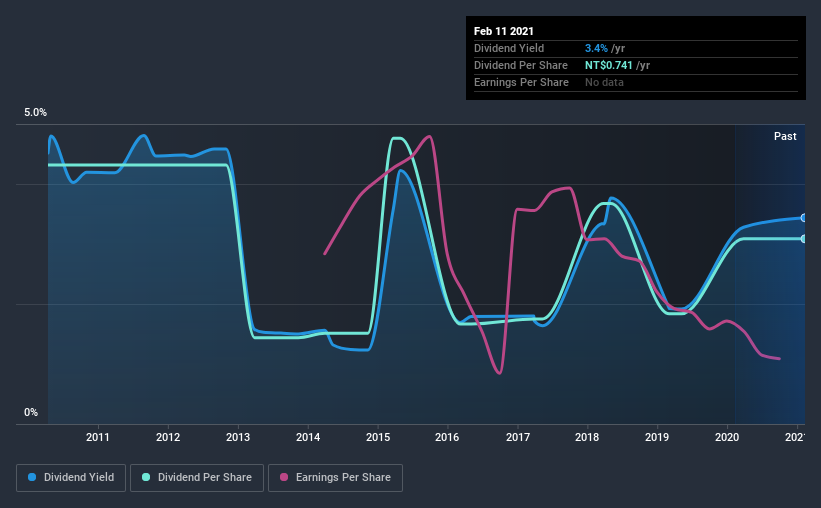Are Dividend Investors Making A Mistake With Sesoda Corporation (TPE:1708)?
Is Sesoda Corporation (TPE:1708) a good dividend stock? How can we tell? Dividend paying companies with growing earnings can be highly rewarding in the long term. Yet sometimes, investors buy a popular dividend stock because of its yield, and then lose money if the company's dividend doesn't live up to expectations.
In this case, Sesoda likely looks attractive to investors, given its 3.4% dividend yield and a payment history of over ten years. We'd guess that plenty of investors have purchased it for the income. Some simple analysis can offer a lot of insights when buying a company for its dividend, and we'll go through this below.
Explore this interactive chart for our latest analysis on Sesoda!

Payout ratios
Dividends are usually paid out of company earnings. If a company is paying more than it earns, then the dividend might become unsustainable - hardly an ideal situation. As a result, we should always investigate whether a company can afford its dividend, measured as a percentage of a company's net income after tax. Sesoda paid out 97% of its profit as dividends, over the trailing twelve month period. With a payout ratio this high, we'd say its dividend is not well covered by earnings. This may be fine if earnings are growing, but it might not take much of a downturn for the dividend to come under pressure.
We also measure dividends paid against a company's levered free cash flow, to see if enough cash was generated to cover the dividend. Sesoda's cash payout ratio in the last year was 27%, which suggests dividends were well covered by cash generated by the business. It's good to see that while Sesoda's dividends were not well covered by profits, at least they are affordable from a free cash flow perspective. Still, if the company continues paying out such a high percentage of its profits, the dividend could be at risk if business turns sour.
Consider getting our latest analysis on Sesoda's financial position here.
Dividend Volatility
Before buying a stock for its income, we want to see if the dividends have been stable in the past, and if the company has a track record of maintaining its dividend. For the purpose of this article, we only scrutinise the last decade of Sesoda's dividend payments. This dividend has been unstable, which we define as having been cut one or more times over this time. During the past 10-year period, the first annual payment was NT$1.0 in 2011, compared to NT$0.7 last year. This works out to be a decline of approximately 3.3% per year over that time. Sesoda's dividend has been cut sharply at least once, so it hasn't fallen by 3.3% every year, but this is a decent approximation of the long term change.
We struggle to make a case for buying Sesoda for its dividend, given that payments have shrunk over the past 10 years.
Dividend Growth Potential
Given that the dividend has been cut in the past, we need to check if earnings are growing and if that might lead to stronger dividends in the future. Over the past five years, it looks as though Sesoda's EPS have declined at around 26% a year. A sharp decline in earnings per share is not great from from a dividend perspective, as even conservative payout ratios can come under pressure if earnings fall far enough.
Conclusion
To summarise, shareholders should always check that Sesoda's dividends are affordable, that its dividend payments are relatively stable, and that it has decent prospects for growing its earnings and dividend. We're a bit uncomfortable with its high payout ratio, although at least the dividend was covered by free cash flow. Earnings per share are down, and Sesoda's dividend has been cut at least once in the past, which is disappointing. In summary, Sesoda has a number of shortcomings that we'd find it hard to get past. Things could change, but we think there are a number of better ideas out there.
Market movements attest to how highly valued a consistent dividend policy is compared to one which is more unpredictable. Still, investors need to consider a host of other factors, apart from dividend payments, when analysing a company. For example, we've identified 4 warning signs for Sesoda (2 can't be ignored!) that you should be aware of before investing.
Looking for more high-yielding dividend ideas? Try our curated list of dividend stocks with a yield above 3%.
If you decide to trade Sesoda, use the lowest-cost* platform that is rated #1 Overall by Barron’s, Interactive Brokers. Trade stocks, options, futures, forex, bonds and funds on 135 markets, all from a single integrated account. Promoted
New: Manage All Your Stock Portfolios in One Place
We've created the ultimate portfolio companion for stock investors, and it's free.
• Connect an unlimited number of Portfolios and see your total in one currency
• Be alerted to new Warning Signs or Risks via email or mobile
• Track the Fair Value of your stocks
This article by Simply Wall St is general in nature. It does not constitute a recommendation to buy or sell any stock, and does not take account of your objectives, or your financial situation. We aim to bring you long-term focused analysis driven by fundamental data. Note that our analysis may not factor in the latest price-sensitive company announcements or qualitative material. Simply Wall St has no position in any stocks mentioned.
*Interactive Brokers Rated Lowest Cost Broker by StockBrokers.com Annual Online Review 2020
Have feedback on this article? Concerned about the content? Get in touch with us directly. Alternatively, email editorial-team (at) simplywallst.com.
About TWSE:1708
Flawless balance sheet established dividend payer.
Market Insights
Community Narratives



